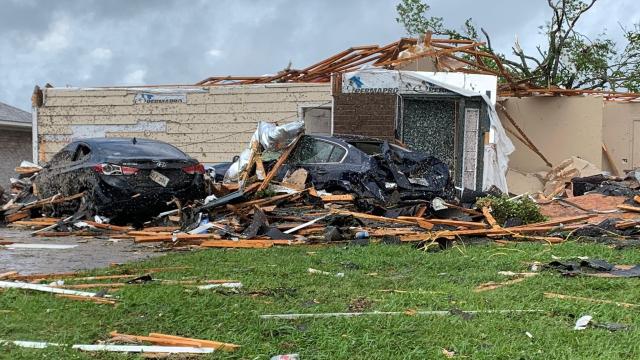Easter Sunday turned deadly in the U.S. South after a wave of violent tornadoes tore through the region. At least 18 have died as a result of the outbreak and the risk of twisters isn’t over yet, as severe weather continues up and down the Eastern Seaboard on Monday.
The National Weather Service received 54 tornado reports on Sunday over an area spanning Texas to North Carolina and issued a number of tornado warnings across the region. While it will take full analysis of the damage on the ground to gauge how strong the tornadoes were, radar put at least one in the range of an EF-5, the strongest rating for twisters.
That includes a tornado that plowed through the small town of Soso, Mississippi located about 30 miles north of Hattiesburg. Radar showed debris being kicked 28,000 feet up into the sky, and photos show a tornado that meteorologists estimated was roughly a mile wide. The tornado was also a long-track one, a term meteorologists use to describe tornadoes that spend an exceptional amount of time on the ground. The town was subsequently buzzed by another tornado an hour later.
The Wedge tornado that moved through Soso and towards Heidelberg was nearly ONE MILE wide. @WJTV #MSwx https://t.co/WNj3cdrHWF
— Jacob Lanier (@JacobLanierWx) April 13, 2020
Huge, destructive tornado in Soso, MS just now @WXgage pic.twitter.com/zpzuEa5erS
— Connor McCrorey (@ConnorWX) April 12, 2020
Other locations also saw widespread destruction. A tornado in Upson County, Georgia ripped a house clean off its foundation and tossed it intact in the street like a horrid reenactment of The Wizard of Oz. An estimated 300 homes were damaged in the town of Monroe, Louisiana, though the city tweeted that it had only received a few reports of minor injuries.
In addition to tornadoes, heavy rain and powerful straight-line winds also wreaked havoc. Sewers and creeks alike backed up, creating flooding problems for communities throughout the region. And downed power lines have left more than 1.2 million customers without power in the region as of Monday morning, according to data collated by PowerOutage.us.
Upson County pic.twitter.com/fFg9EIMhiv
— Molly McCollum (@WXMolly) April 13, 2020
“By the grace of God, early reports show only a few minor injuries. Pray for our city! Many neighbors & friends suffered catastrophic damage. We are hurting; but not broken. Times like this remind us WE ARE STRONGER TOGETHER! Together we we will rebuild.“ – Mayor Jamie Mayo pic.twitter.com/sByzavTiTg
— City of Monroe, LA (@CityofMonroe) April 12, 2020
April is prime time for severe weather in the South, when the air warms up and moisture from the Gulf of Mexico is readily available to fuel storms. But while that can lead to heavy rain and thunderstorms, tornadoes need one more ingredient to occur: rotation. The Easter outbreak was driven by a train of storms cruising over the region that tapped the Gulf of Mexico for energy. At the same time, powerful winds in the upper atmosphere came rushing in from the southwest, causing the storms to start to spin.
The danger of these storms is further amplified by the coronavirus outbreak. With hundreds of homes damaged, it’s possible people will have to stay in shelters that could become hot spots of disease transmission if even just one person staying there is positive. The job losses driven by the pandemic and subsequent economic slowdown could also impede people’s ability to recover after the storm, particularly given the painfully slow pace of U.S. federal assistance even under less trying circumstances.
These types of major tornado outbreaks have become more common in recent decades. It’s possible climate change is playing a role, but the tornado-climate change connection is still very much an area of active research.
Unfortunately, the risk of more tornadoes from this cluster of storms isn’t over yet. Rain and wind will buffet the entire East Coast from Florida to Maine. The National Weather Service has issued Level 2 and 3 warnings for severe weather for more than 31 million people in the Mid-Atlantic and parts of Florida for Monday, and three tornado reports have already come in from the Carolinas.
